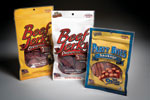
End users are cutting costs, and film manufacturers are responsing with simpler, stronger films.
In the past, when a packager wanted to increase the barrier of a flexible package, he would use a thicker film or switch to a high-performance film that was sophisticated, expensive and multi-layered. However, with costs increasing and sustainable initiatives growing stronger, food and beverage companies are looking for cost-saving films with simpler structures that work just as well.

Pliant's Endurance film line allows for downgauging without losing performance.
No barrier to barrier
Generally, less material equals less cost, and suppliers are reducing film gauge or trying to replace more expensive structures with economical alternatives.However, although food and beverage packagers seek these simpler structures, they often also need strong barrier against moisture or oxygen, or both. One way barrier is being increased is by combining characteristic strengths of different film types.
“The trend is to upgrade monolayer sealant films to coextrusions combining the latest high-performance polymers into one ply,” says Ken Swanson, president of Pliant’s engineered films division.
Additionally, metallization innovations are continuing to evolve, expanding the range of applications and offering an alternative to foil for more high-barrier applications.
Runtime efficiency
But all in all, while companies are looking for material reduction and stronger barriers, other issues factor in.When a packaging line goes down, both time and money are wasted. This is why many film manufacturers work hard at achieving Coefficient of Friction (COF) consistency in their films. Surface conditions can keep a film from running consistently on a line, causing the film to stick or slip, and the line to stop. Manufacturers are treating their films with additives and slip agents to have more control over film COF and keep packaging lines running consistently.
“Barrier and strength properties are a given, but most of the discussion is focused on machinability and broad operating conditions on packaging equipment,” says Swanson. “Today’s packaging applications run both on the latest high-speed equipment and older, worn equipment. Films that run well under all conditions are a necessity.”
Although companies are looking for thinner films that run just as efficiently on a line, just about any change made to a film can affect how well it runs. When it comes to a film’s efficiency, thickness control during manufacturing is of foremost importance.
One particular product that addresses this is Pliant’s Endurance, which has the stiffness and seal characteristics of a 25% thicker film, allowing food and beverage companies to downgauge their packaging without losing performance.
Besides thickness control, consistency in thermal and mechanical properties is also important. Downgauging and simplifying film structures actually helps by increasing heat transfer through the structure and enabling lower seal initiation temperatures (SIT), which helps reduce energy.

Reynolds' Sure-Peel prouch and lidding specifications offer broader sealing windows, increasing line speed by enabling lower seal initiation temperatures and shorter dwell times.
Energy reduction
Since energy costs are high, many plants are looking to lower energy consumption. In return, suppliers are searching for materials with lower SIT and better predictability and performance.Another way SIT can be lowered is by combining polymers, such as a low SIT oriented polypropylene (OPP) with a thin polyethylene terephthalate (PET) outer web to enable higher production results.
According to Eric Bartholomay, product development manager at Toray Plastics (America) Inc., some of the company’s recent developments concentrated on using innovative resin technology to produce films with hermetic sealant designs coupled with lower seal initiation temperatures (SIT).
Also, plastomer and ethylene-vinyl acetate (EVA) polymers, which both have low seal initiation temperatures, can be used in combination with other materials to meet both performance and cost requirements.
It also saves a company money to get things right the first time, so having wider sealing ranges means fewer mis-seals and leakers. Products such as Reynolds’ Sure-Peel pouch and lidding specifications offer broader sealing windows, increasing line speed by enabling lower SIT and shorter dwell times.
Collaboration between machinery and film manufacturers ends the frustrating finger-pointing that usually occurs when a production problem is hard to pin down.
“We also look at the interaction of the packaging machine and the material so that we’re talking with the machinery people and understanding,” says Ed Johnson, director of technology at Printpack’s U.S. flexible division. “I think they’re trying to build in more robust seal jaw designs, and other things like that.”
Rigid to flexible
By replacing rigid packaging with flexible packaging, companies are saving money because of lower transportation costs and impacting the environment less. Printpack looks for rigid packaging alternatives.“[We’re] staying close to the industry about what kind of requirements are going to be placed on the flexible packaging so that we can fill those needs,” says Johnson. “We’re also looking at constantly researching and enabling technologies to be able to make stronger, more rigid flexible materials.”
On the subject of sustainability, converters are also looking at the amount of fossil fuels being used to make films, and what they can do to reduce it.
According to Victoria Welch, marketing communications and community relations director of Reynolds Flexible Packaging, the appropriate flexible packaging product solution can be one that enhances source reduction through lightweighting, improves barrier and protection properties so that other components can be modified, relies less on fossil fuel in its raw material structure or is biodegradable or manufactured from renewable resources.
With all the recent developments in flexible packaging, we’re getting closer to an affordable, high-barrier film that is also environmentally friendly.F&BP
FOR MORE INFORMATION
Pliant Corp.847-969-3300
Printpack
800-241-9985
Reynolds Flexible Packaging
800-327-7768
Toray Plastics (America) Inc.
800-453-6866
